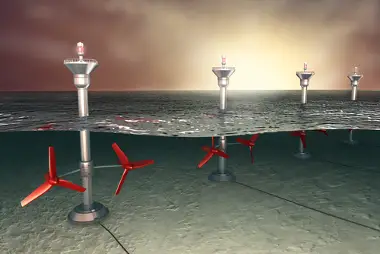
The world's oceans hold a vast and virtually unexplored treasure trove of energy. Marine energy, which encompasses a wide range of renewable energy sources from the sea, is emerging as a promising alternative to meet the growing energy needs of our planet.
In this article, we will look at the different types of marine energy, their advantages and challenges, and their potential for a more sustainable future.
Types of marine energy sources
 Marine energy comprises a variety of energy sources obtained from the ocean. Some of the main sources of marine energy include:
Marine energy comprises a variety of energy sources obtained from the ocean. Some of the main sources of marine energy include:
-
Wave energy: Waves are a constant source of kinetic energy generated by the action of the wind on the sea surface. Wave energy capture devices, such as floating buoys and oscillating columns, convert this motion into electrical energy.
-
Energy from ocean currents: Ocean currents are constant, predictable flows of water that can be used to generate electricity using underwater turbines. These turbines are similar to wind turbines, but operate underwater.
-
Tidal energy: Tidal energy takes advantage of variations in tides caused by the gravitational interaction between the Earth, the Moon and the Sun. Using dikes, dams or floodgate systems, water can be captured and released at high and low tides, generating energy as it flows through turbines.
-
Ocean thermal energy: Ocean thermal energy is derived from the temperature difference between surface waters and deep waters. This temperature gradient is used in closed cycle systems to generate electricity.
Phenomena related to marine energy
Marine energy is related to various natural phenomena related to the oceans and water masses on Earth.
The main phenomena with which this source of energy is related are:
Waves
Wave energy is derived from the action of the wind on the sea surface, which generates wave movements in the water.
These waves contain kinetic energy that can be captured and converted into electricity through devices designed for that purpose.
Ocean currents
Ocean currents are constant, predictable flows of water that occur in the oceans due to differences in temperature, salinity, and other factors.
These currents can be used to generate energy through underwater turbines that capture the kinetic energy of the currents.
Tides
Tidal energy is directly related to the phenomenon of tides. Tides are the result of the gravitational forces exerted by the Moon and the Sun on the Earth, which cause periodic changes in the water level in the oceans.
Changes are used through gate systems or turbines to generate electricity.
Ocean thermal energy
Ocean thermal energy is related to the temperature differences between surface waters and deep waters in the ocean. This temperature difference is used in closed cycle systems to generate thermal energy.
Marine climatology
Marine energy is influenced by marine climatology, which includes weather patterns, winds and weather conditions in the oceans.
These factors can affect marine energy generation, particularly wave and current energy.
Advantages of marine energy
Marine energy offers a number of significant advantages that make it attractive as a renewable energy source:
-
Renewable and predictable: Unlike fossil resources, marine energy is inexhaustible and highly predictable. Waves, currents and tides follow regular patterns, making it easier to plan and operate marine energy facilities.
-
Low carbon emissions: Marine energy generation produces low carbon emissions and does not contribute significantly to climate change. This makes it an environmentally friendly option compared to conventional fossil fuel-based energy sources.
-
Strategic location: Many regions of the world have access to marine energy resources, allowing power generation close to high demand areas, reducing the need for long transmission networks.
-
Lower environmental impact: Compared to some forms of land-based renewable energy, such as wind and solar energy, marine energy often has a lower environmental impact. Underwater devices are less visible and have less impact on terrestrial wildlife.
Disadvantages of marine energy
Despite its advantages, marine energy also faces a number of challenges:
-
High initial costs: The initial investment in marine energy infrastructure is expensive, which can be an obstacle to its large-scale development.
-
Interference with navigation and fishing: Marine energy facilities can interfere with navigation and fishing, requiring consideration of regulations and cooperation with interested parties.
-
Underwater maintenance: Performing maintenance operations in underwater environments can be complicated and expensive.
-
Potential environmental impact: Although it generally has a lower environmental impact compared to some land-based energy sources, marine energy can still impact marine life and local ecosystems.
-
Early stage technological development: Many marine energy technologies are in the development and testing stages, which involves technological risks and the need for continuous improvements.
The potential of marine energy
Despite the challenges, the potential of marine energy is promising.
Some regions are already successfully harnessing these energy sources. For example, Scotland has developed wave and current energy projects, and the Bay of Fundy in Canada is known for its tidal energy. Additionally, countries such as France, China and the United States are investing in research and development of marine energy technologies.
The Intergovernmental Panel on Climate Change (IPCC) has noted that marine energy could play an important role in mitigating climate change.
It is estimated that by 2050, installed marine energy capacity could reach several hundred gigawatts, contributing significantly to global zero-carbon energy generation.
Marine energy also has great potential in islands and coastal regions, where dependence on fossil fuels is often high. It can help diversify the energy matrix and reduce vulnerability to fuel price shocks.


